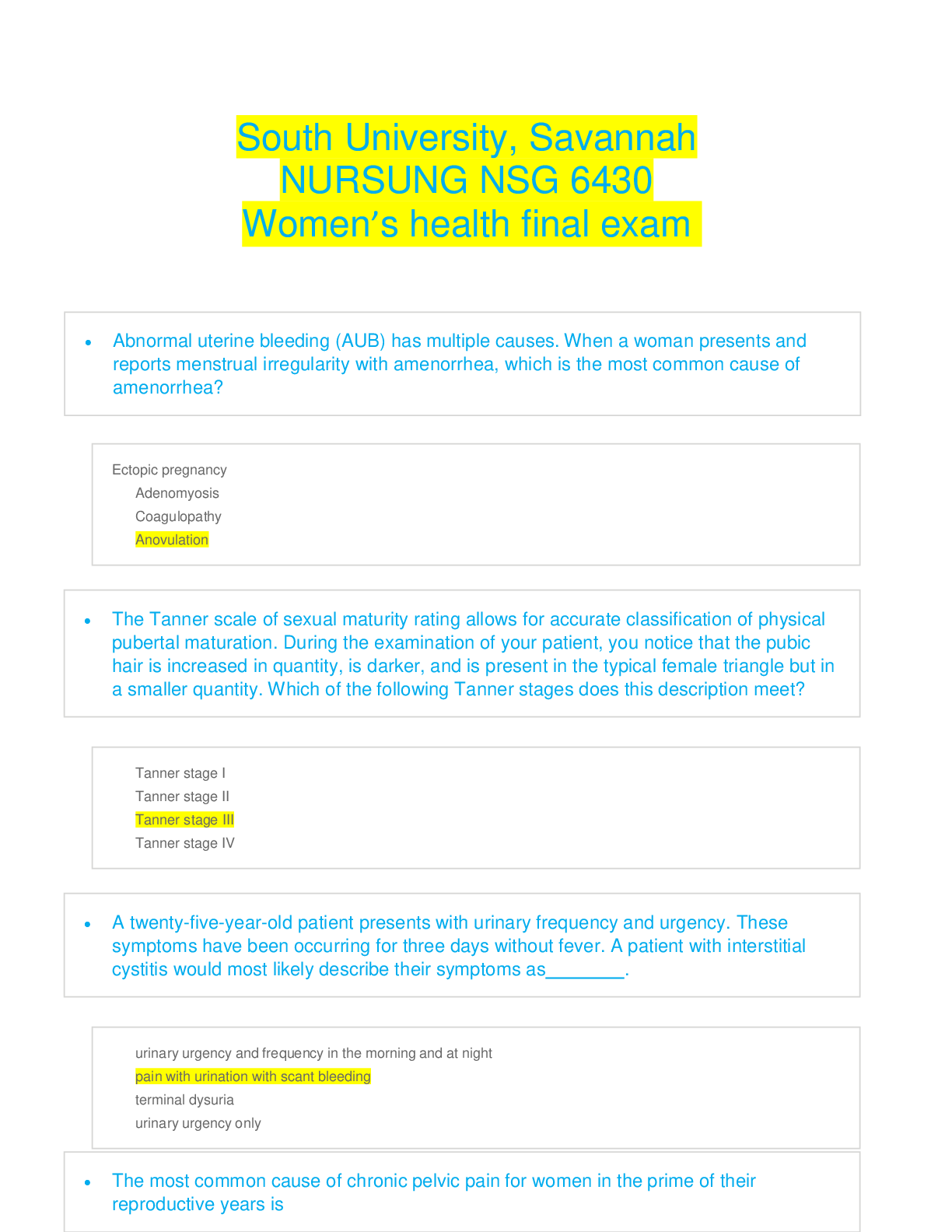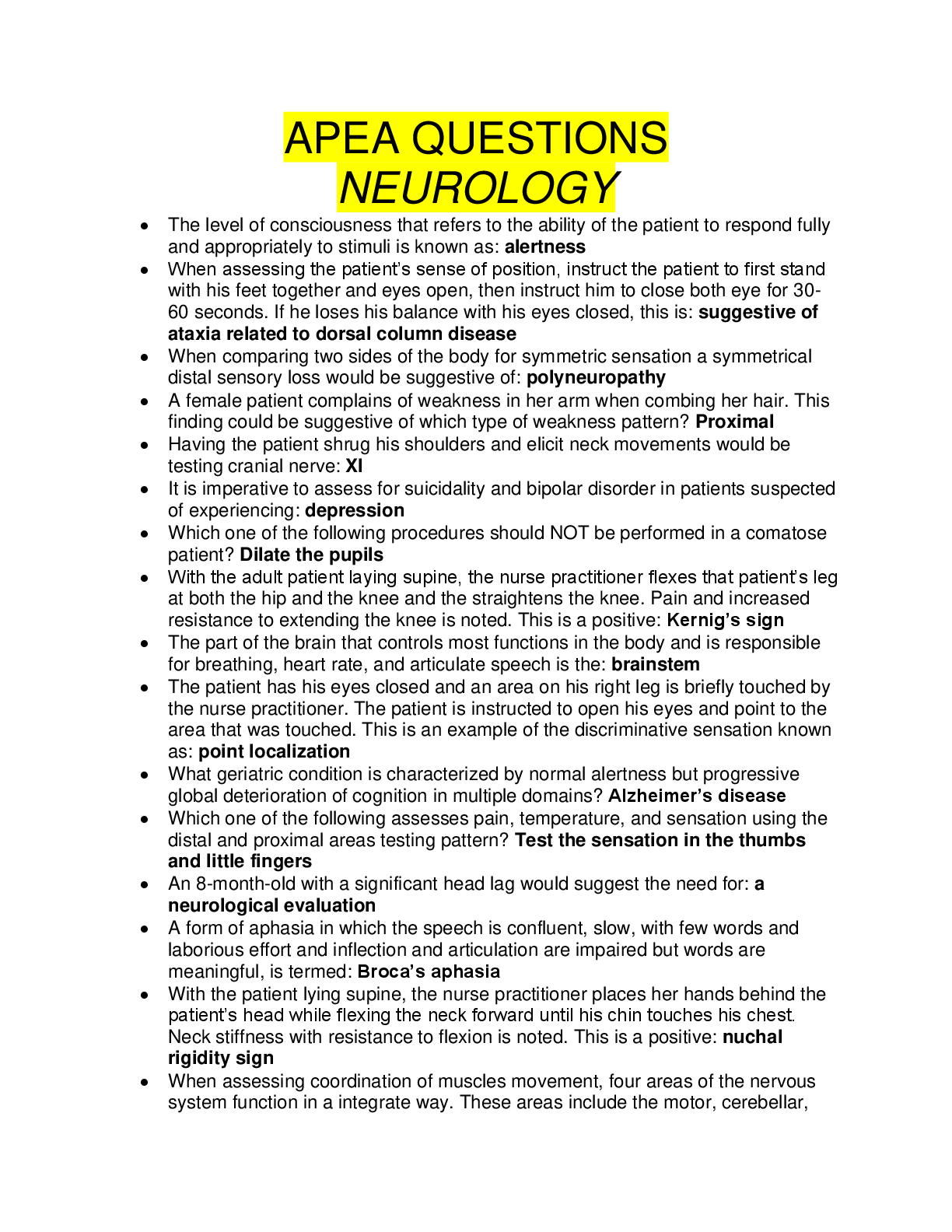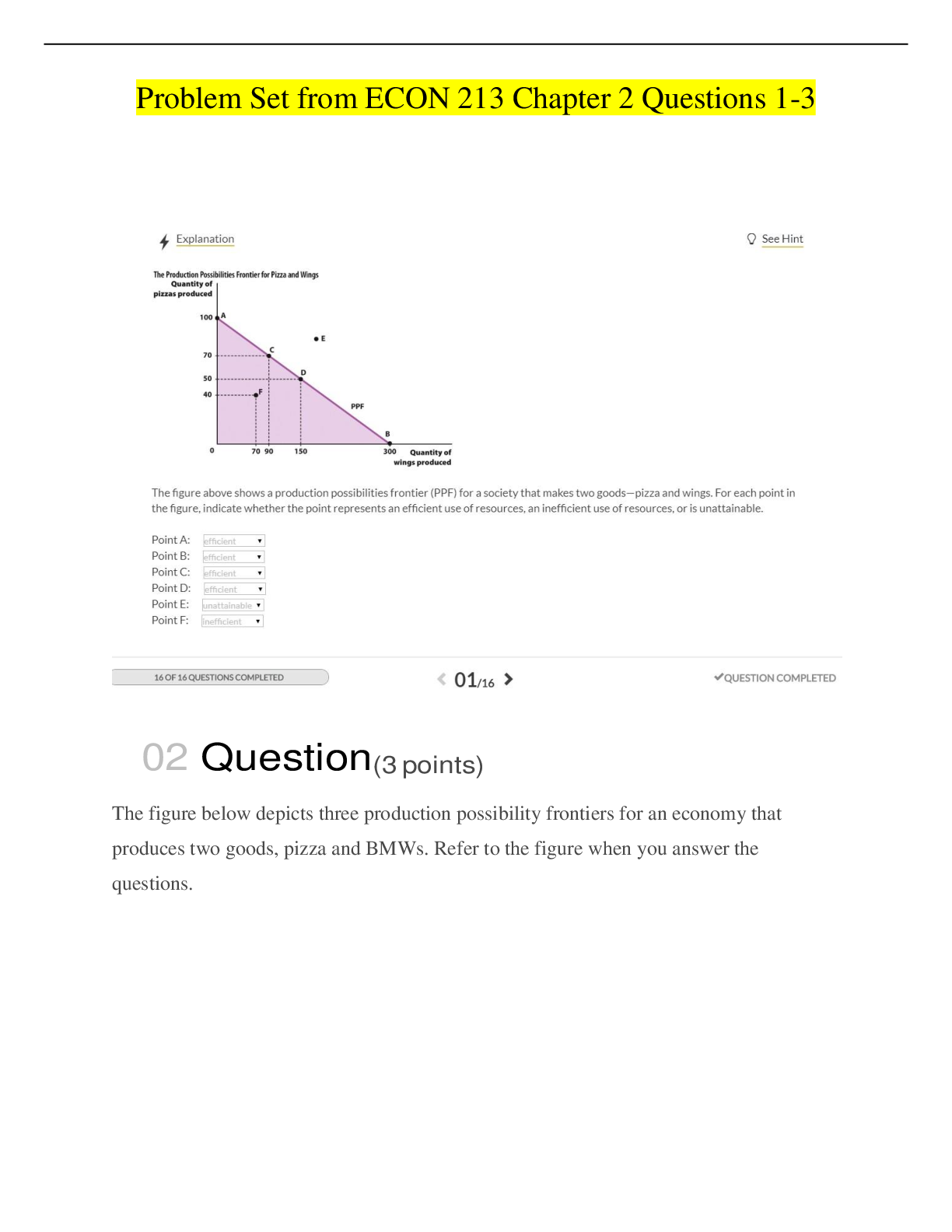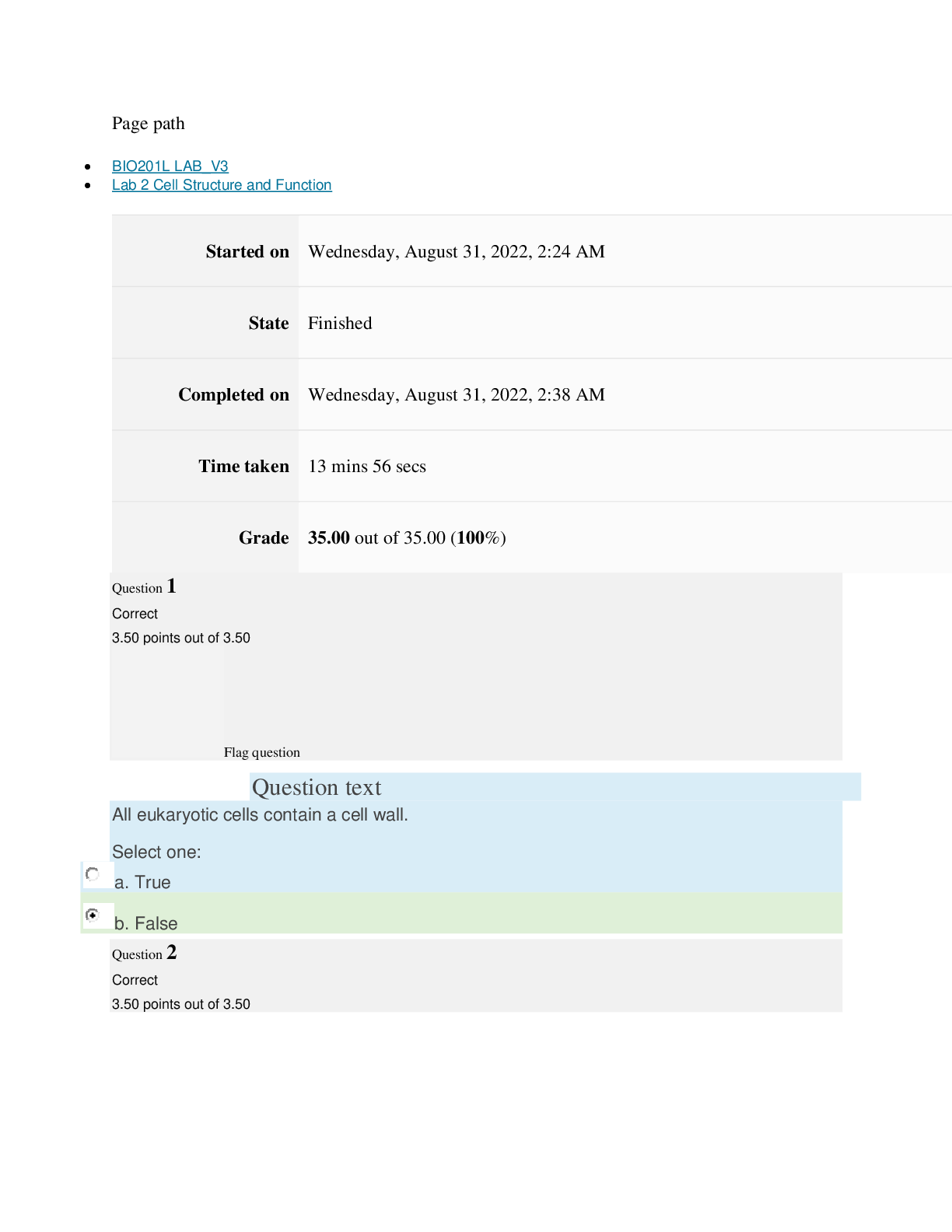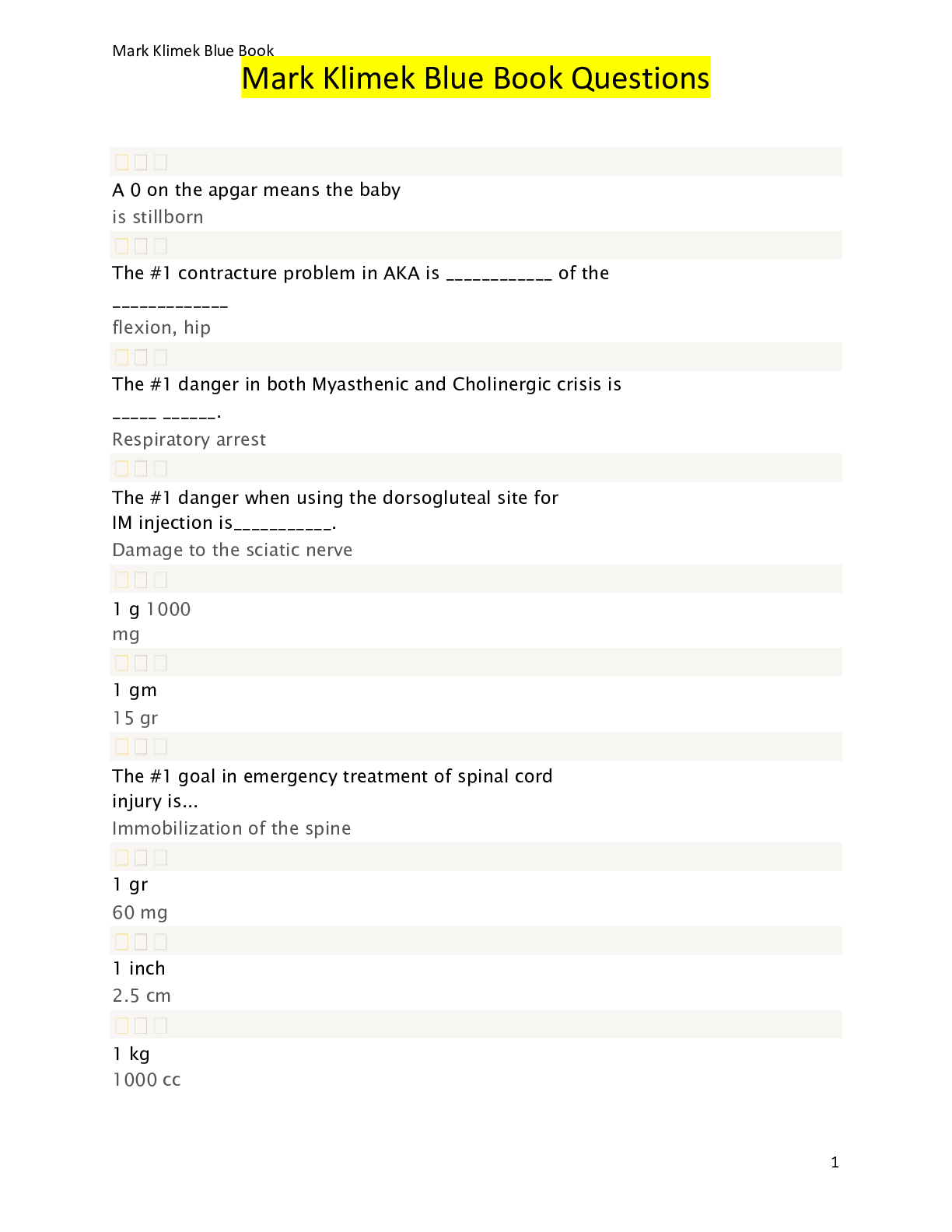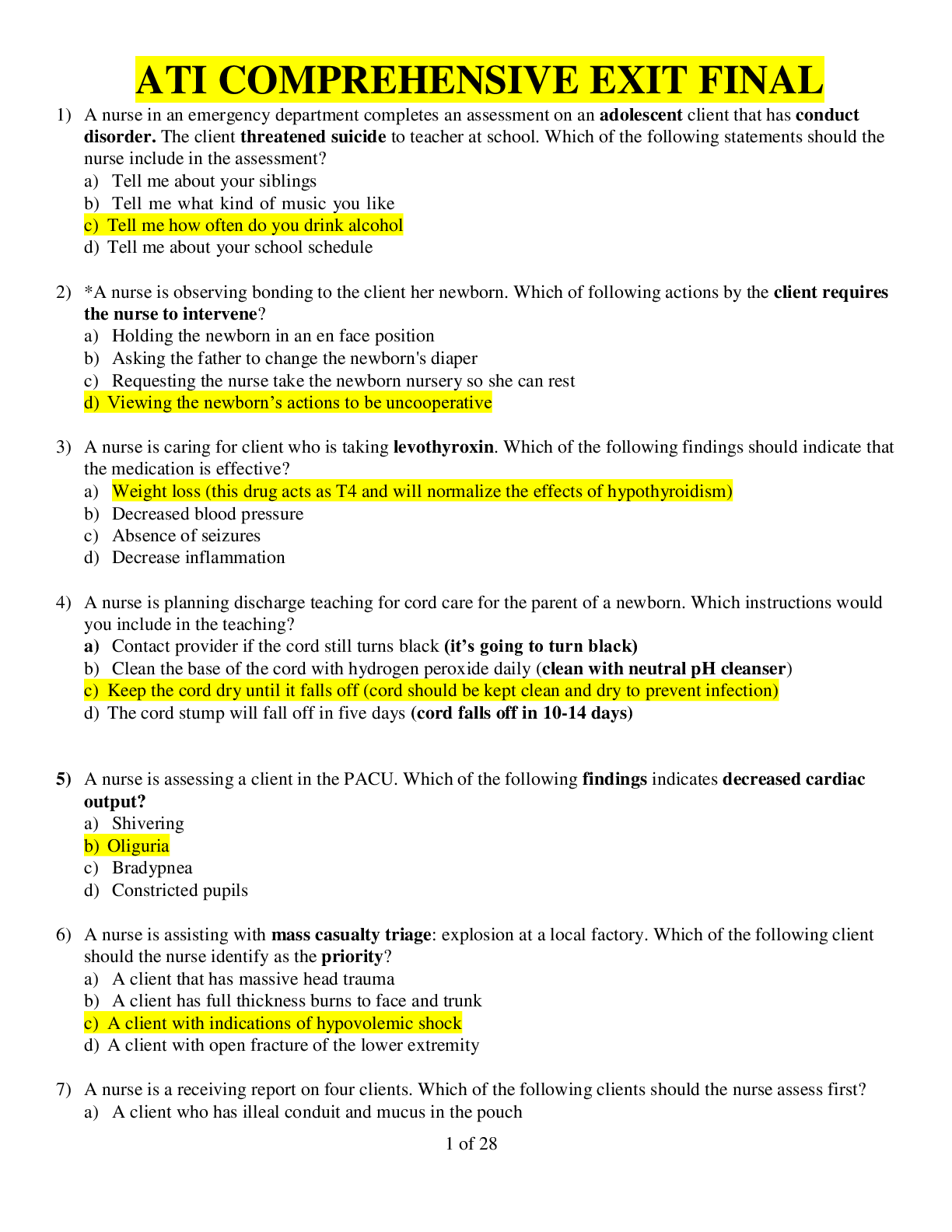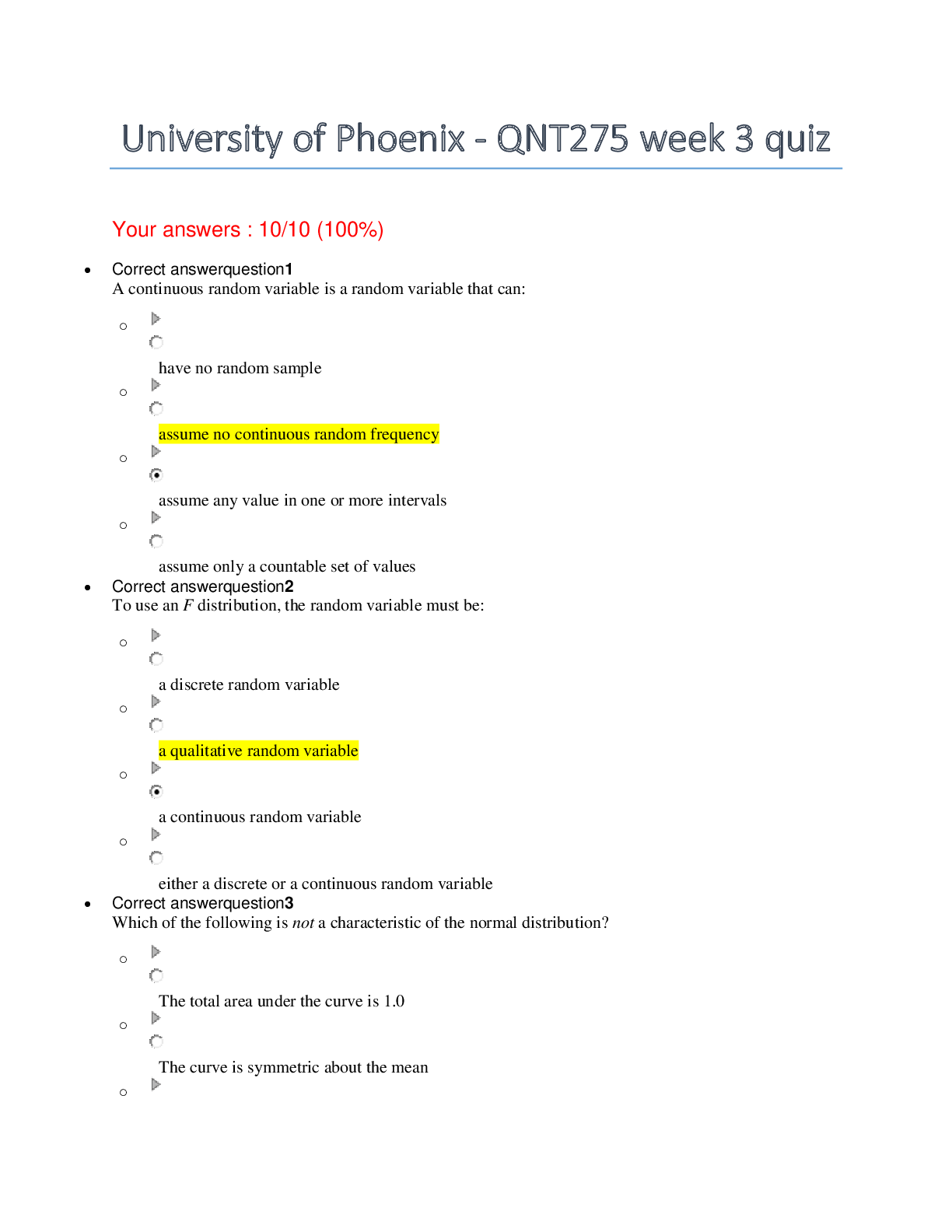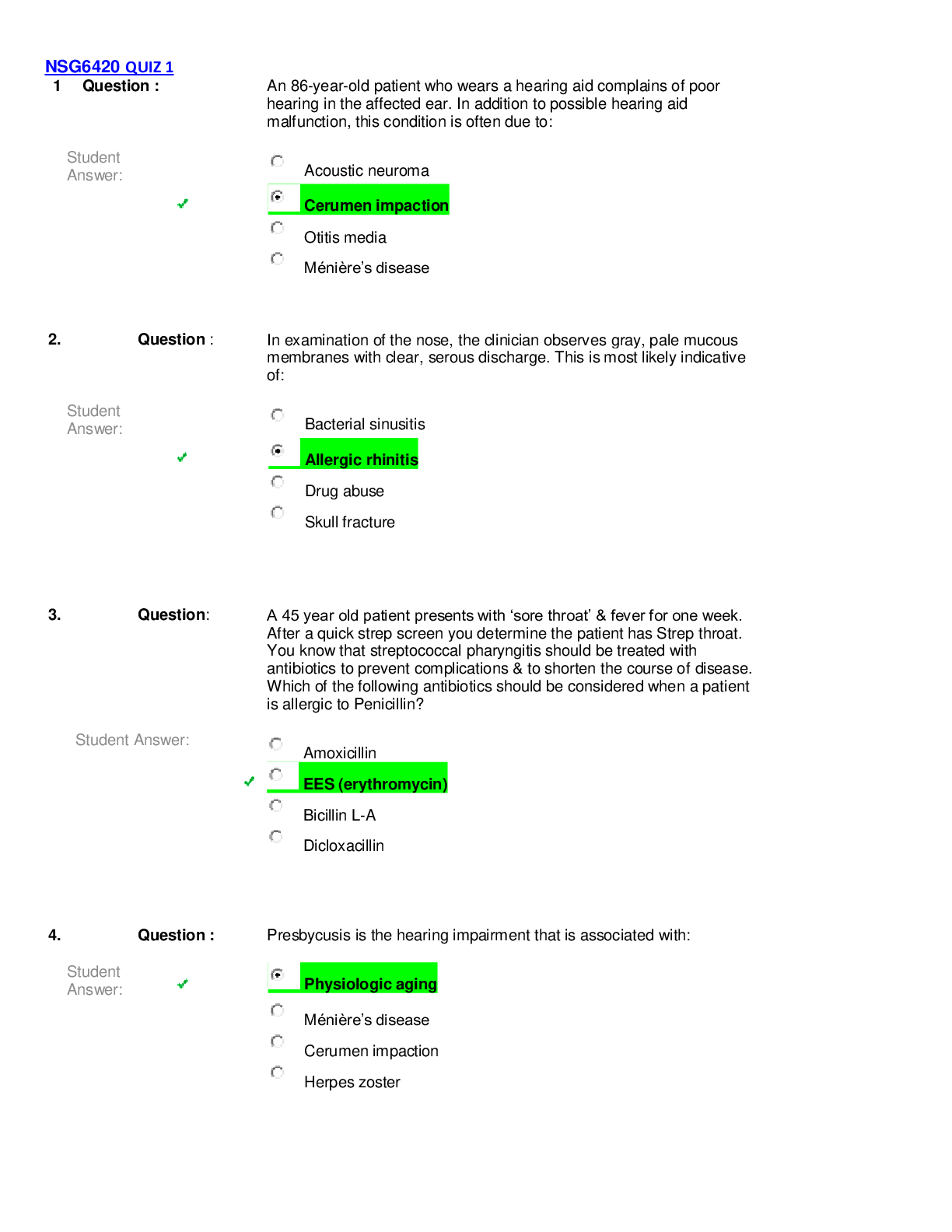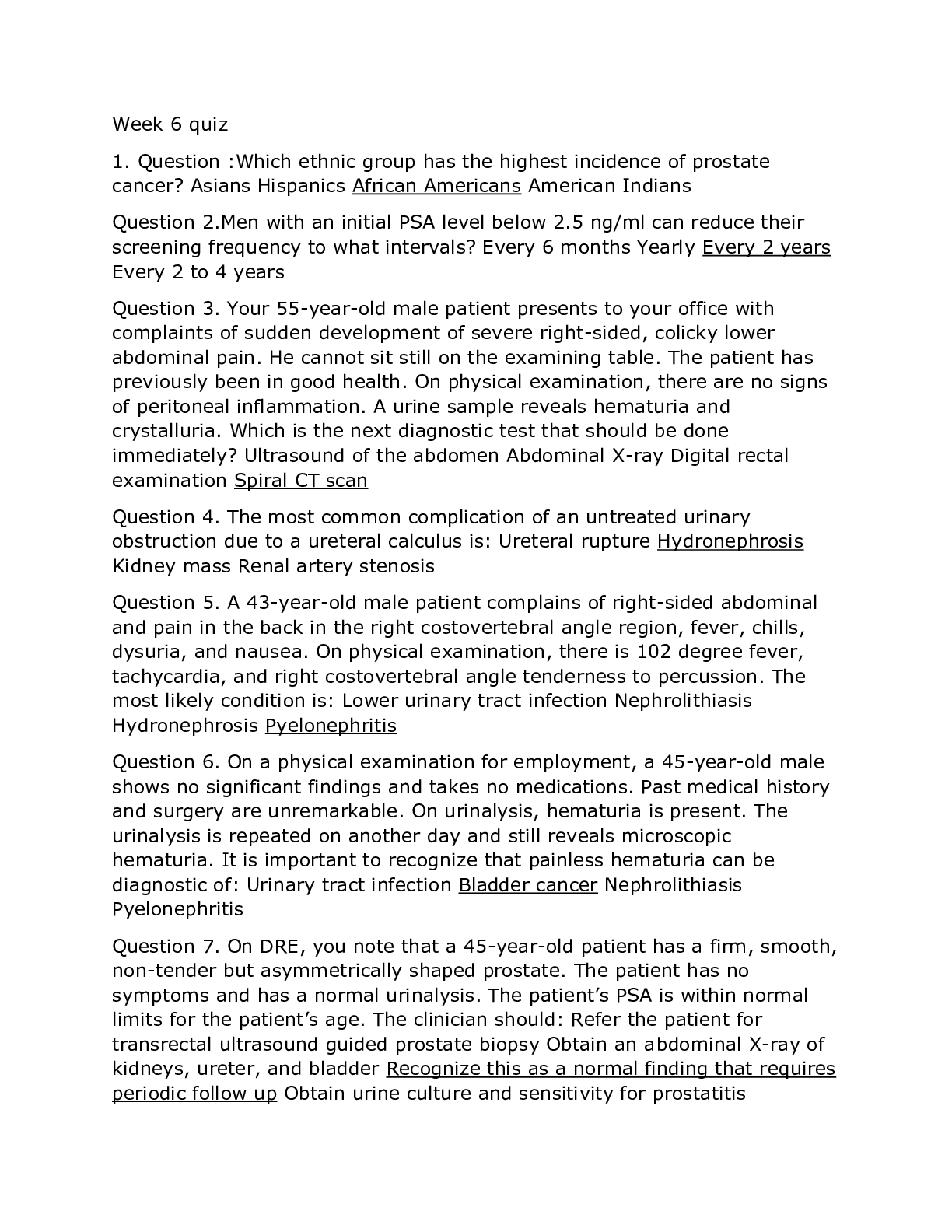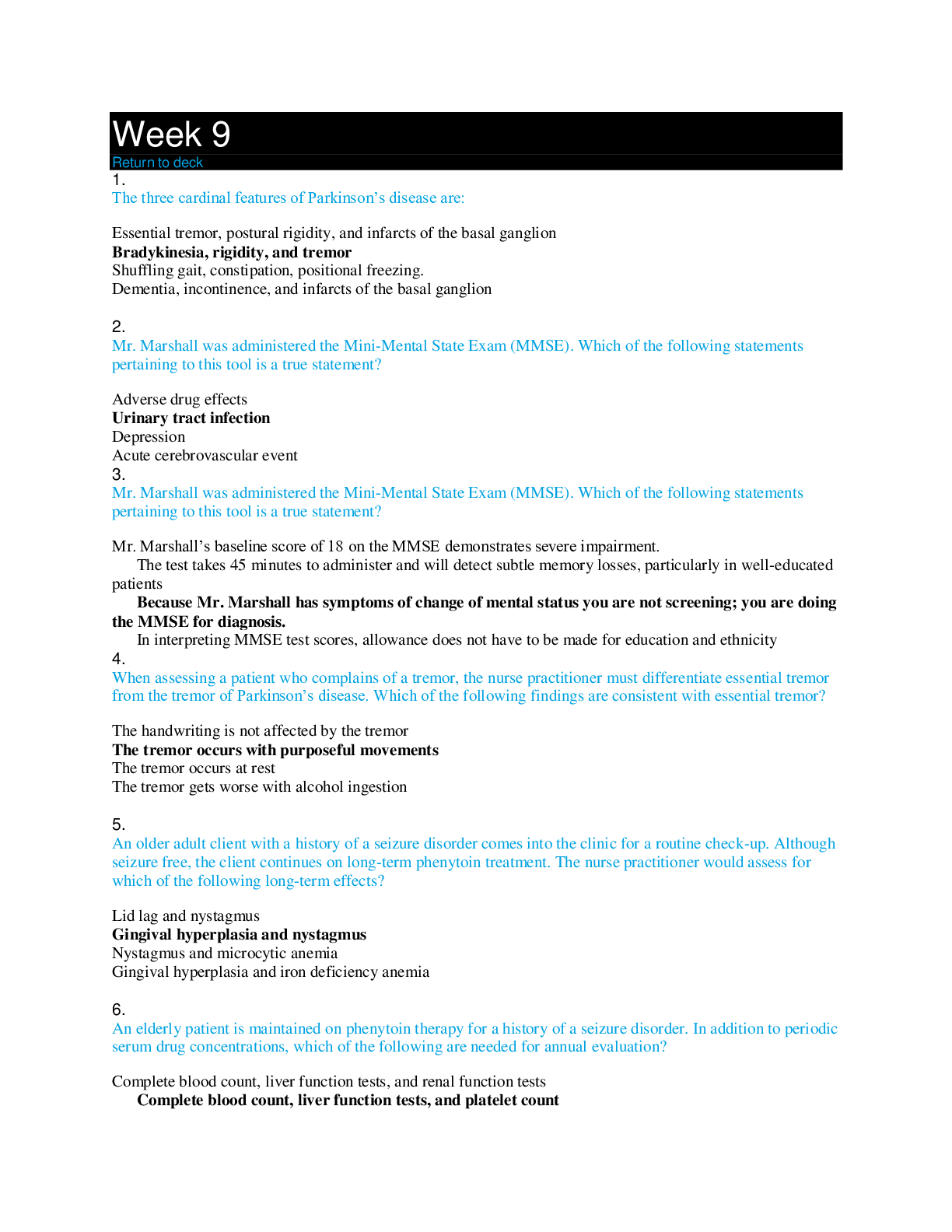*NURSING > QUESTIONS & ANSWERS > South University NSG 6420 Week 3 Quiz / South University NSG6420 Week 3 Quiz (2020, Latest) (Already (All)
South University NSG 6420 Week 3 Quiz / South University NSG6420 Week 3 Quiz (2020, Latest) (Already graded A)
Document Content and Description Below
Week 3 Return to deck 1. Susan P., a 60-year-old woman with a 30 pack year history, presents to your primary care practice for evaluation of a persistent, daily cough with increased sputum producti... on, worse in the morning, occurring over the past three months. She tells you, “I have the same thing, year after year.” Which of the following choices would you consider strongly in your critical thinking process? Seasonal allergies Acute bronchitis Bronchial asthma Chronic bronchitis 2. The pulmonary component includes an abnormal inflammatory response to noxious stimuli, principally tobacco, but also occupational and environmental pollutants. The hallmark of chronic bronchitis is a daily chronic cough with increased sputum production lasting for at least 3 consecutive months in at least 2 consecutive years, usually worse on awakening; this may or may not be associated with COPD (GOLD, 2011). Emphysema is characterized by obstruction to airflow caused by abnormal airspace enlargement distal to terminal bronchioles. Kennedy-Malone, Laurie, Kathleen Fletcher, Lori Martin-Plank. Advanced Practice Nursing in the Care of Older Adults. F.A. Davis Company, 2014-01-14. VitalBook file. (page 206) 3. A patient presents complaining of a 5 day history of upper respiratory symptoms including nasal congestion and drainage. On the day the symptoms began he had a low-grade fever that has now resolved. His nasal congestion persisted and he has had yellow nasal drainage for three days associated with mild headaches. On exam he is afebrile and in no distress. Examination of his tympanic membranes and throat are normal. Examination of his nose is unremarkable although a slight yellowish-clear drainage is noted. There is tenderness when you lightly percuss his maxillary sinus. What would your treatment plan for this patient be? Observation and reassurance Treatment with an antibiotic such as amoxicillin Treatment with an antibiotic such as a fluoroquinoline or amoxicillin-clavulanate Combination of a low dose inhaled corticosteroid and a long acting beta2 agonist inhaler. 4. A previously healthy 24 year old man presents at a clinic in Southern New England ten days after a weekend camping trip. He reports the appearance of a painless skin lesion on his right thigh five days previously. He now notes malaise, low-grade fever, and migrating joint pain of 48 hours duration. Careful questioning fails to elicit any recent history of an insect bite. The lesion on the thigh had begun to fade, but you recognize an area of central clearing with an erythematous margin. Further examination reveals a second, similar lesion near the right axilla. Question: The patient referred to in the scenario returns three days later complaining of worsening weakness and lightheadedness. His pulse is 42 and his pressure in the supine position is 90/40. You quickly obtain an EKG, which reveals third degree heart block. The best management at this point would include: A) Add oral cefuroxime 500mg po bid to his antibiotic regimen. B) Stop all antibiotics immediately and administer Benadryl 50mg intramuscularly stat. C) Administer atropine 1mg intravenously, observe the patient for 4 hours and discharge if he remains stable. D) Admit the patient for cardiac monitoring and begin intravenous ceftriaxone 2g per day. E) Stop all antibiotics immediately and admit the patient for electrophysiological studies. The correct answer is: D About 8% of patients with Lyme disease will develop cardiac involvement, usually some form of atrioventricular block. Patients with third degree heart block should be treated with intravenous ceftriaxone until the heart block resolves and then complete a 30-day course of oral antibiotics. The development of neurological symptoms also requires treatment with intravenous antibiotics. Ref: ID/ Harrison's 16, p. 996, 998/ RAL 5. . When palpating the posterior chest, the clinician notes increased tactile fremitus over the left lower lobe. This can be indicative of pneumonia. Areas of increased fremitus should raise the suspicion of conditions resulting in increased solidity or consolidation in the underlying lung tissue, such as in pneumonia, tumor, or pulmonary fibrosis. In the instance of an extensive bronchial obstruction: No palpable vibration is felt Decreased fremitus is felt Increased fremitus is felt Vibration is referred to the non-obstructed lobe Instructor Explanation: Areas of increased fremitus should raise the suspicion of conditions resulting in increased solidity or consolidation in the underlying lung tissue, such as in pneumonia, tumor, or pulmonary fibrosis. Conversely, areas of decreased fremitus raise the suspicion of abnormal fluid- or air-filled spaces, such as occurs with pleural effusion, pneumothorax, or emphysema. In the instance of an extensive bronchial obstruction, no palpable vibration is felt in the related field. Goolsby, Mary J., Laurie Grubbs. Advanced Assessment Interpreting Findings and Formulating Differential Diagnoses, 3rd Edition. F.A. Davis Company, 11/2014. VitalBook file. (page 209) & Kennedy-Malone, Laurie, Kathleen Fletcher, Lori Martin-Plank. Advanced Practice Nursing in the Care of Older Adults. F.A. Davis Company, 2014-01-14. VitalBook file. (page 193) 6. Your patient presents with complaint of persistent cough. After you have finished obtaining the History of Present Illness, you realize that the patient may be having episodes of wheezing, in addition to his cough. The most common cause of cough with wheezing is asthma. What of the following physical exam findings will support your tentative diagnosis of asthma? Clear, watery nasal drainage with nasal turbinate swelling Pharyngeal exudate and lymphadenopathy Clubbing, cyanosis and edema. Diminished lung sounds with rales in both bases 7. Which of the following imaging studies should be considered if a pulmonary malignancy is suspected Computed tomography (CT) scan Chest X-ray with PA, lateral, and lordotic views Ultrasound Positron emission tomography (PET) scan 8. A 26-year-old, non-smoker, male presented to your clinic with SOB with exertion. This could be due to Exercise-induced cough Bronchiectasis Alpha-1 deficiency Pericarditis 9. Upon assessment of respiratory excursion, the clinician notes asymmetric expansion of the chest. One side expands greater than the other. This could be due to Pneumothorax Pleural effusion Pneumonia Pulmonary embolismefinition 10. A 72-year-old woman and her husband are on a cross-country driving vacation. After a long day of driving, they stop for dinner. Midway through the meal, the woman becomes very short of breath, with chest pain and a feeling of panic. Which of the following problems is most likely? Pulmonary edema Heart failure Pulmonary embolism Pneumonia 11. A cough is described as chronic if it has been present for Greater than 8 weeks 12. Testing is necessary for the diagnosis of asthma because history and physical are not reliable means of excluding other diagnoses or determining the extent of lung impairment. What is the study that is used to evaluate upper respiratory symptoms with new onset wheeze? Chest X-ray Methacholine challenge test Spirometry, both with and without bronchodilation Ventilation/perfusion scan 13. . Your patient has just returned from a 6-month missionary trip to Southeast Asia. He reports unremitting cough, hemoptysis, and an unintentional weight loss of 10 pounds over the last month. These symptoms should prompt the clinician to suspect: Legionnaires' disease Malaria Tuberculosis Pneumonia 14. Your patient has just returned from a 6-month missionary trip to Southeast Asia. He reports unremitting cough, hemoptysis, and an unintentional weight loss of 10 pounds over the last month. These symptoms should prompt the clinician to suspect: Legionnaires' disease Malaria Tuberculosis Pneumonia 15. A 76-year-old patient with a 200-pack year smoking history presents with complaints of chronic cough, dyspnea, fatigue, hemoptysis, and weight loss over the past 2 months. The physical exam reveals decreased breath sounds and dullness to percussion over the left lower lung field. The chest X-ray demonstrates shift of the mediastinum and trachea to the left. These are classic signs of: Lung cancer Tuberculosis Pneumonia COPD 16. A 24-year-old patient presents to the emergency department after sustaining multiple traumatic injuries after a motorcycle accident. Upon examination, you note tachypnea, use of intercostal muscles to breathe, asymmetric chest expansion, and no breath sounds over the left lower lobe. It is most important to suspect: Pulmonary embolism Pleural effusion Pneumothorax Fracture of ribs 17. A 23-year-old patient who has had bronchiectasis since childhood is likely to have which ofthe following: Barrel-shaped chest Clubbing Pectus excavatum Prolonged capillary refill 18. Which of the following is considered a “red flag” when diagnosing a patient with pneumonia Fever of 102 Infiltrates on chest X-ray Pleural effusion on chest X-ray Elevated white blood cell count 19. A 75-year-old patient with community-acquired pneumonia presents with chills, productive cough, temperature of 102.1, pulse 100, respiration 18, BP 90/52, WBC 12,000, and blood urea nitrogen (BUN) 22 mg/dl. He has a history of mild dementia and his mental status is unchanged from his last visit. These findings indicate that the patient: Can be treated as an outpatient Requires hospitalization for treatment Requires a high dose of parenteral antibiotic Can be treated with oral antibiotics 20. The following criterion is considered a positive finding when determining whether a patient with asthma can be safely monitored and treated at home: Age over 40 Fever greater than 101 Tachypnea greater than 30 breaths/minute Productive cough 21. In classifying the severity of your patient presenting with an acute exacerbation of asthma. You determine that they have moderate persistent symptoms based on the report of symptoms and spirometry readings of the last 3 weeks. The findings that support moderate persistent symptoms include: Symptoms daily with nighttime awakening more than 1 time a week. FEV1 >60%, but predicted <80%. FEV1/FVC reduced 5% [Show More]
Last updated: 2 years ago
Preview 1 out of 4 pages

Buy this document to get the full access instantly
Instant Download Access after purchase
Buy NowInstant download
We Accept:

Reviews( 0 )
$6.00
Can't find what you want? Try our AI powered Search
Document information
Connected school, study & course
About the document
Uploaded On
Apr 09, 2020
Number of pages
4
Written in
Additional information
This document has been written for:
Uploaded
Apr 09, 2020
Downloads
0
Views
199

